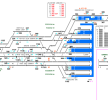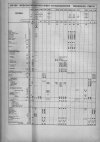@jfollows was your era using Piccadilly too late for the early evening train to St Pancras that used Platform 10 or 11? I remember it from the early 70s; it was invariably a Midland Lines 45, which must have worked the train in from far afield. I don’t think there was a crosssover anywhere other than 5/6; maybe the 08 that appeared from time to time was used to carry out some (relatively) complex shunting?
During my era for sure.
The wide platform between platforms 10 & 11 was a road, which incidentally provided a totally barrier-free exit route from the station also, and platform 10 was only used during busy periods (but for passenger trains). Its first use during the afternoon/evening peak was for the 16:10 to Macclesfield, which I used regularly, and I'd sit on it and observe the comings and goings on platform 11, which was to load 1M25 18:08 Parcels to Saint Pancras. I think the stock for this came, in part, from 5M54 13:27 Nunnery CS to Longsight, on which I once snagged a ride in the back cab of the Class 25, and the stock was probably shunted into platform 11 later in the afternoon after 4V21 15:21 Parcels to Bristol left, but the locomotive was 0M84 17:44 Longsight-Piccadilly.
There was no other crossover between platforms, and platform 12 was an oily slick by then and probably completely out of use but with the rails in place still, they were removed later as shown by the diagram above, which post-dates the extension of platforms 13 and 14 which required the severing of direct routes out of the higher numbered platforms to the layout we pretty much see today once platform 12 was reinstated.
EDIT In the 6/4/74 to 4/5/75 timetable, during my era, the stock for 1M84 18:06 Piccadilly - Saint Pancras (changed to 1M25 in later timetables, hence the inconsistencies above) was provided by 5M84 15:21 ECS from Longsight which ran into platform 12 with its diesel engine on front and "Shunts to platform 11" presumably to release the engine.


 . I lived in Manchester area in 1978/79 - there was a class 76 hauled evening parcels train through Guide Bridge I saw a few times, not sure if that went as far as Piccadilly?
. I lived in Manchester area in 1978/79 - there was a class 76 hauled evening parcels train through Guide Bridge I saw a few times, not sure if that went as far as Piccadilly?